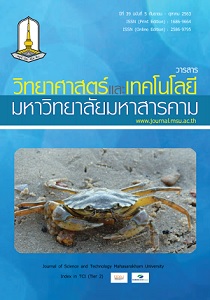Development of facial essence from mushroom extract
Main Article Content
Abstract
In this study, the essence containing mushroom extract was developed and evaluated the stability of the product. Auricularia auricular-judae (Bull.), Pleurotus sajor-caju (Fr.) Sing. and Pleurotus osttreatus (Fr.) Kummer were extracted and determined total polysaccharide by Phenol – sulfuric acid method, total phenolic content by Folin-ciocalteu method, and antioxidant activity by DPPH assay. The selected mushroom extract was developed the facial essence and evaluated the physical and chemical stability. The results found that P. osttreatus extract contained the highest polysaccharide at 90.01%. P. osttreatus extract showed highest total phenolic content at 0.783 ± 0.03 mg GAE/g. A. auricular-judae extract presented the highest free radical scavenging activity at the IC50 value of 159.55±21.47 µg/ml. Dried P. osttreatus was extracted by hot water which exhibited great bioactivities was selected to develop the facial essence containing gelling agent. After the stability test, this formulation showed the acceptable stability. Therefore, the essence containing P. osttreatus extract has the potential for further developed as a cosmetic product.
Article Details
References
2. Wu Y, Choi MH, Li J, Yang H, Shin HJ. Mushroom cosmetics: The present and future. Cosmetics. 2016;3(3):1–13.
3. Synytsya A, Míčková K, Synytsya A, Jablonský I, Spěváček J, Erban V, et al. Glucans from fruit bodies of cultivated mushrooms Pleurotus ostreatus and Pleurotus eryngii: Structure and potential prebiotic activity. Carbohydr Polym. 2009 May 16;76(4):548–56.
4. Kanlayavattanakul M, Lourith N. Biopolysaccharides for Skin Hydrating Cosmetics. In: Polysaccharides. Cham: Springer International Publishing; 2015. p. 1867–92.
5. อัศวพิชยนต์ พ. การประยุกต์ใช้เทคโนโลยีพอลิเมอร์เพื่อพัฒนาตำรับเครื่องสำอางและผลิตภัณฑ์เพื่อสุขภาพ. In: เหลืองธนะอนันต์ ม, editor. คณะเภสัชศาสตร์ มหาวิทยาลัยศิลปากร; 2546. p. 253.
6. El Enshasy HA, Hatti-Kaul R. Mushroom immunomodulators: unique molecules with unlimited applications. Trends Biotechnol. 2013 Dec;31(12):668–77.
7. Kesari M, Collge J. Studies on Phytochemical Compounds and Antioxidant Potential of Auricularia Auricula-Judae Studies on Phytochemical Compounds and Antioxidant Potential of. Int J Pharm Sci Res. 2017;8(8):3508–15.
8. Finimundy TC, Barros L, Calhelha RC, Alves MJ, Prieto MA, Abreu RMV, et al. Multifunctions of Pleurotus sajor-caju (Fr.) Singer: A highly nutritious food and a source for bioactive compounds. Food Chem. 2018 Apr 15;245:150–8.
9. Piska K, Sułkowska-Ziaja K, Muszyńska B. EDIBLE MUSHROOM Pleurotus ostreatus (OYSTER MUSHROOM)-ITS DIETARY SIGNIFICANCE AND BIOLOGICAL ACTIVITY. Acta Sci Pol Hortorum Cultus. 2017;16(1):151–61.
10. Masuko T, Minami A, Iwasaki N, Majima T, Nishimura S-I, Lee YC. Carbohydrate analysis by a phenol–sulfuric acid method in microplate format. Anal Biochem. 2005 Apr 1;339(1):69–72.
11. ช่วยเจริญ ภ. ผลของการต้มต่อฤทธิ์ต้านอนุมูลอิสระในเห็ดออรินจิ เห็ดหูหนูดำ เห็ดนางฟ้า และเห็ดหอม. รายงานการประชุมวิชาการและนำเสนอผลการวิจัย ระดับชาติและนานาชาติ กลุ่มระดับชาติ ด้านวิทยาศาสตร์. 2015 Jun 6;1(6):382–90.
12. Bhatti M, Kamboj A, Saluja AK. Spectrophotometric estimation of total polysaccharides in Kalanchoe pinnatum and Kalanchoe crenata. Int J Pharm Pharm Sci. 2013;5(2):40–1.
13. Xi X, Wei X, Wang Y, Chu Q, Xiao J. Determination of tea polysaccharides in Camellia sinensis by a modified phenol-sulfuric acid method. Vol. 62, Archives of Biological Sciences. 2010. p. 669–76.
14. Patil SS, Ahmed SA, Telang SM, Baig MMV. the Nutritional Value of Pleurotus Ostreatus ( Jacq .: Fr .) Kumm Cultivated on Different Lignocellulosic Agro- Wastes. Innov Rom Food Biotechnol. 2010;7(September):66–76.
15. Livingston DP. Fructan Precipitation from a Water/Ethanol Extract of Oats and Barley. Plant Physiol. 1990 Mar 1;92(3):767–9.
16. Liao WC, Hsueh C-Y, Chan C-F. Antioxidative activity, moisture retention, film formation, and viscosity stability of Auricularia fuscosuccinea , white strain water extract. Biosci Biotechnol Biochem. 2014 Jun 3;78(6):1029–36.
17. Ferreira I, Barros L, Abreu R. Antioxidants in Wild Mushrooms. Curr Med Chem. 2009 Apr 1;16(12):1543–60.
18. Panthong S, Boonsathorn N, Chuchawankul S, Mol G. Antioxidant activity, anti-proliferative activity, and amino acid profiles of ethanolic extracts of edible mushrooms. Genet Mol Res. 2016;15(4):15048886.
19. Klaus A, Kozarski M, Niksic M, Jakovljevic D, Todorovic N, Van Griensven LJLD. Antioxidative activities and chemical characterization of polysaccharides extracted from the basidiomycete Schizophyllum commune. LWT - Food Sci Technol. 2011 Dec 1;44(10):2005–11.
20. Tseng Y-H, Yang J-H, Mau J-L. Antioxidant properties of polysaccharides from Ganoderma tsugae. Food Chem. 2008 Mar 15;107(2):732–8.
21. Li X, Wang Z, Wang L, Walid E, Zhang H. In vitro antioxidant and anti-proliferation activities of polysaccharides from various extracts of different mushrooms. Int J Mol Sci. 2012;13(5):5801–17.
22. Khaskheli SG, Zheng W, Sheikh SA, Khaskheli AA, Liu Y, Soomro AH, et al. Characterization of Auricularia auricula polysaccharides and its antioxidant properties in fresh and pickled product. Int J Biol Macromol. 2015 Nov 1;81:387–95.


